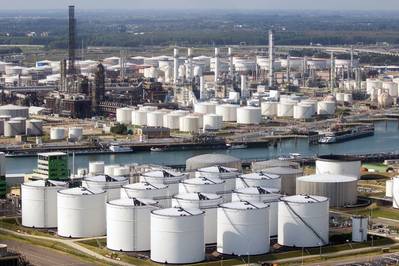Oil prices ended down more than 2 percent on Wednesday after hitting a 10-month low in volatile trade, as growing U.S. production and reduced Chinese refinery activity fed mounting concern over the stubborn global crude glut.
U.S. crude futures settled at $42.53, down 98 cents or 2.3 percent, after touching a low of $42.13, the lowest intraday level since August 2016. Since peaking in late February, crude has dropped more than 20 percent, with only brief rallies.
More than 1 million front-month crude contracts changed hands on Wednesday, far exceeding the daily average of 560,000 contracts.
Brent crude futures settled down $1.20 or 2.61 percent at $44.82 a barrel.
"The market wants proof that OPEC cuts are shifting petroleum balances, and it's not getting it. Crude prices are now on the hunt to find the stress point for the U.S. producers and we're not there yet," said Anthony Headrick, energy market analyst at CHS Hedging LLC in Inver Grove Heights, Minnesota.
Oil prices rose in late 2016 and early 2017 in response to the OPEC agreement, but weeks of surprisingly high inventory figures shifted sentiment among speculators who are shedding long positions as the crude glut persists.
The U.S. Energy Information Administration said crude inventories declined by 2.7 million barrels last week, exceeding expectations for a 2.1 million-barrel drop. The data briefly supported prices, but "updated inventory balances don't represent a game changer," said Headrick.
The EIA also reported that U.S. crude production rose to 9.35 million bpd, nearing levels of top producers Russia and Saudi Arabia. U.S. producers have added rigs for 22 weeks straight.
Oil has slid 20 percent in the first half of 2017, a period when prices have tended to rise. It was the biggest first half slide for Brent since 1997; the contract has risen in the first half of all but six years over that period.
An agreement late last year from the Organization of the Petroleum Exporting Countries and other producers to cut output by 1.8 million barrels per day from January was supposed to reduce the global glut. Yet production is rising in Nigeria and Libya, countries exempt from the deal, offsetting cuts by other OPEC members.
Nigeria's crude exports are set to surpass 2 million barrels per day (bpd) in August, the highest in 17 months.
Iranian oil minister Bijan Zanganeh said OPEC members were considering deeper output cuts, but not immediately.
Investors were discouraged by data showing oil refineries in China, the world's top crude importer, cutting operations during the peak demand summer season.
The December 2017 U.S. crude contract is at its biggest discount to December 2018 futures since July, a signal that traders expect the glut to persist even longer. Options activity picked up on Wednesday as well, as investors bought protection against further declines.
"Now everyone seems to be negative," said Commerzbank analyst Eugen Weinberg.
In the U.S. Gulf of Mexico, oil facilities braced for Tropical Storm Cindy. About 17 percent of oil production in the Gulf was shut in and 40 platforms, or about 5 percent, were evacuated. Prolonged outages at refineries could drive up gasoline prices.
(By Julia Simon; Additional reporting by Amanda Cooper in London, Aaron Sheldrick in Tokyo; Editing by David Gregorio)




